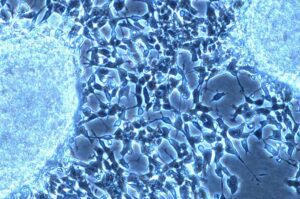Scientists report disturbing reproductive health trends around the world, and research shows that pesticides are at least partly to blame.
The American Congress of Obstetricians and Gynecologists points to a growing body of scientific evidence linking chemicals to many reproductive health harms. Research is particularly strong linking pesticide exposure to reduced sperm count and quality, early puberty in girls, birth defects, miscarriage and stillbirth. According to the Association of Reproductive Health Professionals, many of these impacts are on the rise, worldwide.
Hormones, disrupted
 One group of chemicals — endocrine disruptors — are particularly prone to interfere with reproductive health, even when exposure levels are extremely low. Some of these chemicals mimic human hormones or otherwise interfere with hormone-controlled systems, which can block (or put into overdrive) a range of biological processes.
One group of chemicals — endocrine disruptors — are particularly prone to interfere with reproductive health, even when exposure levels are extremely low. Some of these chemicals mimic human hormones or otherwise interfere with hormone-controlled systems, which can block (or put into overdrive) a range of biological processes.
Throughout a lifetime, endocrine-disrupting chemicals can damage the reproductive system in a number of ways. Some kill or damage cells; if these are sperm cells or oocytes, infertility can result. Others alter DNA structure, causing gene mutations that may result in birth defects or an inability to conceive.
Some chemicals can even cause “epigenetic” effects, meaning they change the way genes are expressed — not just for those exposed, but potentially for future generations too.
More detailed explanations — and compelling evidence of the scope of the problem — are outlined in Generations at Risk, a book co-authored by Dr. Ted Schettler, a former member of PAN’s Board of Directors.
Timing is everything
 An infant in the womb is particularly vulnerable to endocrine-disrupting chemicals, as hormones are busy regulating the differentiation of cells and development of organs.
An infant in the womb is particularly vulnerable to endocrine-disrupting chemicals, as hormones are busy regulating the differentiation of cells and development of organs.
Infants exposed to the wrong chemical just when the reproductive organs are forming can experience harm that plays out over the course of a lifetime. Scientists from the national Endocrine Society explain why the timing of exposure is so important:
In those cases in which disruption is directed toward programming of a function, e.g., reproductive health, this may interfere with early life organization, followed by a latent period, after which the function becomes activated and the dysfunction can become obvious.
In other words, exposure to chemicals when an infant’s reproductive system is developing can completely derail the process. But we don’t know it’s happened until years later, when problems arise during puberty or when trying to conceive.
Pesticides: A key culprit
 Scientists now understand that exposure to pesticides can cause a wide range of reproductive harms affecting men, women and children alike.
Scientists now understand that exposure to pesticides can cause a wide range of reproductive harms affecting men, women and children alike.
Just a few of many recent studies:
- In the first study of its kind, scientists at Harvard found that men who ate food with more pesticide residue had lower sperm count and fewer normal sperm.
- Exposure to the herbicide atrazine has been linked to menstrual disorders, low-birth weight babies and birth defects.
- A 2013 study linked legacy pesticides, including the organochlorine insecticide lindane, to increased risk of endometriosis in women.
Pesticides have also been implicated in miscarriage, premature birth, reduced fertility in both men and women and altered sex ratio (fewer boys being born). And the science is only getting stronger.
For those interested in diving deeper, we recently summarized emerging science on pesticides and male infertility for PSR’s Environmental Health Policy Institute. Our partners at Beyond Pesticides also keep a list of recent studies on pesticide impacts on reproductive health.
The Collaborative on Health and the Environment maintains a database that rates the strength of the scientific evidence linking chemicals to reproductive harms among both men and women. The Our Stolen Future website also tracks the latest studies on how pesticides and other chemicals threaten the complex process of human reproduction.







